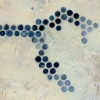Table of Contents

|
Introduction: What is Remote Sensing? |

|
1. Physical Basics
The chapter Physical Basics or Remote Sensing discusses the electromagnetic spectrum, radiation and absorption principles, atmospheric influences and spectral reflectance properties. |

|
2. Satellites
The chapter on Satellites covers different satellite orbits and sensors, followed by an overview of exemplary earth observation satellites (LANDSAT, SPOT 5, Ikonos 2, Radarsat, Meteosat 8, Quickbird 2, ERS 2, Envisat, IRS P6, NOAA 18, GOES 12). |

|
3. Resolution
The chapter on Resolutions describes the image content in geometric, spectral, radiometric and temporal ways. |

|
4. Visual Image Interpretation
In this chapter the basics of visual interpretation of satellite images are presented. What are the different steps for analysing and interpreting true colour satellite images? |
 |
5. Image Processing
Image Processing or enhancement is used before interpreting or classifying an image. Following a section on pre-processing steps such as geometric and radiometric correction some enhancement possibilities are presented. |
 |
6. Image Classification
The final step of interpreting a satellite image is the classification procedure. Unsupervised and supervised image classification methods are described in this chapter after clarifying why a classification is useful. |
|
|
7. Educational Games
A total of 10 games were developed to deepen your knowledge about the basics of remote sensing. |
|
|
8. References
A list of references of literature and data sources as well as suggestions for further reading. |
|
|
9. Image credits
A list of image credits and copyright is given here. |
|
|
10. Links
A list of useful external links (for getting satellite images, virtual globes etc.) |
|
|
11. Authors
A list of the authors who created the learning module about the basics of remote sensing. |
|
|
12. Worksheets
A list of worksheets. |
|
|
13. Worksheets
A list of worksheets and related information for use in class. |
